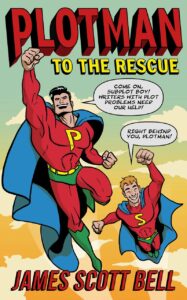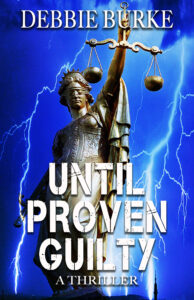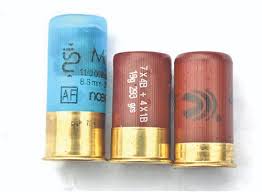by James Scott Bell
@jamesscottbell
 (Today’s post is adapted from the book Plotman to the Rescue: A Troubleshooting Guide to Fixing Your Toughest Plot Problems. It is used by the kind permission of the author.)
(Today’s post is adapted from the book Plotman to the Rescue: A Troubleshooting Guide to Fixing Your Toughest Plot Problems. It is used by the kind permission of the author.)
Here’s a question I get from time to time. What do I do if I’m in the middle of my novel and there are so many things happening, so many characters running around, that I’m losing my way?
You would think this question would come primarily from “pantsers,” the If-I-knew-what-my-story-was-about-before-I-wrote-it-I’d-be-bored school of writing. But it arises with the plotter, too, who has perhaps been overly ambitious in the planning. As sometimes happens for the plot engineers, a sudden twist or turn or character may try to horn in at, say, the 20k mark, throwing the whole outline off.
So what do you do when you discover you’ve a) gone down that infamous rabbit hole; b) have plot points or characters popping up you didn’t plan for; c) are lost in a dark forest; or d) have fallen off a cliff into the bleached bones of the author’s graveyard?
I will allow you one wail of frustration.
Now let’s get a handle on things.
First of all, where are you, as the ad men used to say, “outline wise”? Do not skip over this part, pantsers, for you better have an outline, too.
Wait, what?
I’m talking about a “rolling outline,” one you put together as you roll along. When you finish a scene or chapter, write a quick synopsis of who the viewpoint character is, what he wants and what happens, as in: Ishmael gets depressed, decides to go to sea, and sets off to find a ship.
Scrivener is ideal for this because you can put the rolling outline on scene “cards” and view them on a virtual corkboard. But Word or even Excel will work fine, too.
Now, if you feel your plot is getting away from you, print out the current version of the rolling outline and do this:
Clean House on Characters
How many viewpoint characters have you got? This means you have more than one character with a storyline of their own. For example, in a traditional romance you usually have two viewpoint characters, the lovers. In a long historical or fantasy novel, you may have three, four or more.
If this is so for you, precisely define the following: What is each character’s death-stakes objective? (Death being physical, professional, or psychological.) If it’s not death, find a way to make it so, or drop this as a plotline. In the alternative, consider taking away this character’s viewpoint scenes and converting that line into a subplot. This means the character shows up in scenes told from another character’s point of view and (this is crucial) complicates the viewpoint character’s objective.
For example, you have a woman as a viewpoint character, and a man as another viewpoint character. The man’s plotline is not working out in a death-stakes way. You might remove him as a viewpoint, but have him show up in the woman’s plotline as a potential lover or long-lost brother or secret agent or alien from a parallel universe.
Clean house. Keep only the crucial characters.
For further study: The Stand by Stephen King, and Strangers by Dean Koontz. You’ll see how these authors make the several character lines work on their own terms before bringing the strands together.
Cut Scenes That Don’t Connect to Plot
Now that you are squared away on the objective of the main character or characters, assess each scene you’ve written so far. Ask:
- Does the goal in the scene relate in some way to the overall, death-stakes objective of the Lead? If not, cut it.
- Does the scene present an obstacle to the attainment of the objective, emotionally or physically or both? If not, why is it there?
- If the scene is part of a subplot, how does it intersect with the main plot? How does it complicate matters for the Lead?
Write or Rewrite Your Pitch
If you’re a pantser, you may not have a pitch for your novel. After all, you’re still discovering what it’s about! Well, if you’ve done some thinking as this post suggests, you’ve made discoveries. Try putting them together in a pitch—250 words or less that would make someone interested in this story. Doing this will give you focus on where to go next.
If you’re an outliner, rewrite your pitch to include the elements you’ve uncovered. Get excited again about your journey.
Be sure to read Sue’s post on crafting a pitch.
Push On
Now finish your draft. Don’t do any more dawdling. You should have enough direction to push right on to the end. As you do, keep adding to your rolling outline. It will be helpful when you get to the editing stage.
Can you describe a time when your plot got away from you, or you felt lost? Is this a common occurrence for you? What do you do to get back on track?


 your special interest kicks in and you can’t wait to tell the rest of us how exciting it is to study entomology and the Giant Weta.
your special interest kicks in and you can’t wait to tell the rest of us how exciting it is to study entomology and the Giant Weta. Today is National Tolkien Reading Day. How many of Tolkien’s books have you read? Bonus points for naming them. Which was your favorite and why?
Today is National Tolkien Reading Day. How many of Tolkien’s books have you read? Bonus points for naming them. Which was your favorite and why?


 Shotguns also give you many options in terms of ammunition, and you should base your choice on a number of factors, not the least of which is where you live. (See above.)
Shotguns also give you many options in terms of ammunition, and you should base your choice on a number of factors, not the least of which is where you live. (See above.) When most people think “shotgun”, I believe they see the venerable 12-gauge shoulder buster that is featured in cop shows. Deployed properly, it’ll definitely do a number on the bad guy, but an apartment dweller needs to give serious consideration to the size of the shot and power of the loads he’s using. One of the commenters on Sue’s post on Monday posited the use of a 12 gauge slug against an intruder. Um, no. Not unless he’s fifty yards away and looks like an attacking grizzly bear.
When most people think “shotgun”, I believe they see the venerable 12-gauge shoulder buster that is featured in cop shows. Deployed properly, it’ll definitely do a number on the bad guy, but an apartment dweller needs to give serious consideration to the size of the shot and power of the loads he’s using. One of the commenters on Sue’s post on Monday posited the use of a 12 gauge slug against an intruder. Um, no. Not unless he’s fifty yards away and looks like an attacking grizzly bear. In most circumstances, even 00 (“double-aught”) buckshot is too hot for home defense. Every trigger pull of 00 buck launches 9 to14 .33 caliber pellets down range at 1,700 feet per second, give or take. It will drop whatever you hit, and at short ranges will likely pass right through your target with little reduction in speed. I think that a .410 shotgun loaded with #4 shot (.24 caliber pellets) is a better choice. It’s got far less recoil, but plenty of umph to stop your intruder. Even the hotter versions of birdshot will take the invader out of commission, and will pose less chance of collateral damage.
In most circumstances, even 00 (“double-aught”) buckshot is too hot for home defense. Every trigger pull of 00 buck launches 9 to14 .33 caliber pellets down range at 1,700 feet per second, give or take. It will drop whatever you hit, and at short ranges will likely pass right through your target with little reduction in speed. I think that a .410 shotgun loaded with #4 shot (.24 caliber pellets) is a better choice. It’s got far less recoil, but plenty of umph to stop your intruder. Even the hotter versions of birdshot will take the invader out of commission, and will pose less chance of collateral damage. If the shotgun in your closet is already a 12 gauge, consider “short loads”, which have considerably less powder, and therefore lessen the hazards to your neighbors.
If the shotgun in your closet is already a 12 gauge, consider “short loads”, which have considerably less powder, and therefore lessen the hazards to your neighbors. A crash startles you awake. Is it real? Are you dreaming?
A crash startles you awake. Is it real? Are you dreaming? In
In  Here’s a fun little exercise I’ve used from time to time to jumpstart the ol’ creative battery. It only takes about 90 seconds.
Here’s a fun little exercise I’ve used from time to time to jumpstart the ol’ creative battery. It only takes about 90 seconds. 